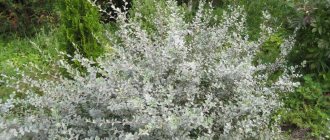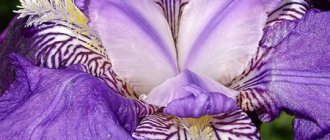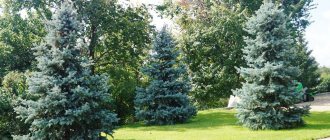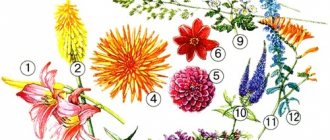Flowers Fritillaria (Fritillaria) belong to the genus of herbaceous perennials and to the Liliaceae family. There are more than 150 varieties of this plant in the world. Habitat: Northern Hemisphere, where a temperate climate predominates, as well as Asia. Due to its visual similarity to a cup for discarding bones, in Latin it is called “fritillus” - translated as “pockmarked” or “variegated”, which is how its Russian name appeared.
Description, features
A perennial plant that reproduces from seeds or bulbs. Their structure is curious, since it has no top cover and literally consists of many scales.
If they are damaged, this will lead to the death of the hazel grouse.
Some gardeners prefer to call the plant the tree of paradise for its resemblance to a lush palm tree. The flowers are drooping, differ in different shades, can be collected in groups or arranged one at a time.
Gardeners consider this plant necessary on the site, since, in addition to its beauty, it also has benefits. It is believed that the smell spreading from the flower effectively drives out moles and mole crickets. Some gardeners, planting it around the perimeter of the site, try to protect themselves from rodents.
Types of hazel grouse
It is customary to distinguish two varieties of plants based on their habitat. The humid climate of the middle zone is considered ideal for the first group. Their height is only 40-80 cm, the color can be different.
These include:
- chess;
- Russian;
- Ussuri;
- checkerboard;
- whorled;
- cirrhosis;
- mountain and others.
The second group of these flowers is represented by exhibits that prefer the dry and hot climate of southern Europe and Asian countries.
The Imperial hazel grouse is considered the tallest member of this group, with flowers of a yellow or orange hue.
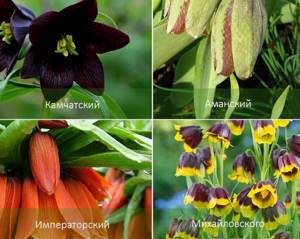
There are also very small plants belonging to this group: broad-leaved, oriental, Zagros or large-flowered hazel grouse. The most common colors of these flowers are burgundy and purple. They are great for creating rock gardens.
Flowers with a silvery bloom look especially delicate and delight the eye with different shades. These types include the Caucasian, Armenian, Albura, yellow and golden varieties. Kamchatka, Olga, needle petal and others are distinguished by the most delicate colors with notes of greenery and cream shades.
| View | Description |
| Imperial (Royal) | Among gardeners, the most common species is the Imperial or Royal hazel grouse. It differs from other varieties of this flower in size. The stem of the plant reaches 90-120 cm in height; at its top there are beautiful large flowers. The flowering period coincides with tulips and cherries. Colors vary from bright yellow to brick red. It is very difficult to confuse this species with others, since its tubers have a very specific smell. |
| Chess | The fastest reproduction and unpretentiousness in maintenance is observed in the chess hazel grouse. We sell only white-headed varieties Alba and Aphrodite. In total, biologists know more than a dozen varieties of this plant species. Beloved by gardeners in Russia and Europe, the checkerboard hazel grouse is distinguished by large flowers with a bright checkerboard color. The “cells” stand out clearly on the brownish-pink petals. The flower grows in forest thickets and withstands wintering and spring flooding well. The color of the buds varies - from purple to pure white. Reproduction is sometimes done by self-sowing. |
| Mikhailovsky | A fragile flower, only 25 cm high with two burgundy buds with a yellow border along the edge. The plant is unpretentious and survives the winter well. Today, it is possible to grow a miniature copy of this variety of hazel grouse, the height of which does not exceed 15 cm. Dry and warm soil is best suited for them. Reproduction of this species mainly occurs by seeds. It is recommended to dig up and warm the bulbs at least once every 2-3 years, especially in humid and cold climates. |
| Russian | This plant variety is listed in the Red Book. In nature, it is found on mountain slopes or steppes. The height of the stem reaches 40 cm, the flowers are large, of a bright chocolate color. |
| Modest | Its small size and delicate colors give this variety its name. On a short, no more than 20 cm, stem there is only one bright yellow bud. Reproduction of this variety of hazel grouse requires a lot of diligence and time. It is planted in well-warmed soil with drainage. Flowering occurs early, immediately after the snow melts, and in winter it is grown on the windowsill, in a pot. |
| Persian | The variety has been known since the 19th century and came to us from eastern countries. The stem grows up to 100 cm in height, the inflorescences are arranged in a cone with about 30 bright flowers. The leaves of the plant have a blue tint, and the flowers are almost black. It looks very unusual and beautiful. It is better to grow such a flower in well-warmed soil mixed with sand, on the south side of the site, where it is warm and the sun's rays fall. It also overwinters well, but requires high-quality cover with dry foliage. |
| Kamchatsky | As the name suggests, the flower variety of the same name, Ryabchik, grows in Kamchatka. It reaches a height of 60 cm, the flowers can be almost black or bright yellow. The bulbs of this variety are very similar in scales to lily bulbs. Reproduction can also be done using scales. |
| Amansky | This variety is young, grown since the 70s of the last century. It mainly grows on limestone slopes with tall shrubs and grass. The mountain slopes of Libya, Turkey, and Syria are considered the homeland of this variety. The plant is small, the height of the stem reaches 25 cm, it is very fragile, the flowers are greenish in color with purple splashes. A large number of flowers grow from one small bulb. It is better to plant it on the sunny side of the garden, in soil with good drainage, adding lime or chalk. The flower tolerates wintering well, but it should not be planted in open ground in the fall. |
Varieties of imperial hazel grouse
Also check out these articles
- Currant Lvovyanka
- Dipladenia (Mandevilla) flower
- Raspberry Gusar
- How to prune currants correctly in the fall
There are many interesting varieties of imperial hazel grouse.
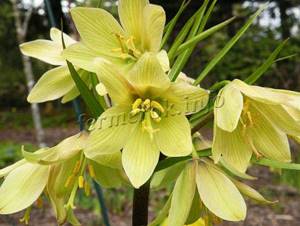
Photo of Raddeana's Fritillary (Fritillaria imperialis Raddeana)
- Raddeana (Fritillaria imperialis Raddeana) is a strong plant that can be grown even in unfavorable conditions. The color of the buds is cream or yellow. The main difference of the variety is its large flowers. Each brush contains an average of 5 flowers. Flowering lasts approximately 14 days.
- Rubra (Fritillaria imperialis Rubra) is a variety that reaches a height of 60 cm during flowering. The flowers are red and quite large.
- Striped Beauty (Fritillaria imperialis Striped Beauty) produces large orange or golden buds. Flowering lasts approximately 1.5 months.
- Garland Star (Fritillaria imperialis Garland Star) is another beautiful variety. It is distinguished by a bright crown of abundant flowers on the top of the stems. The color of the flowers is bright red.
- Lutea (Fritillaria imperialis Lutea) is distinguished by yellow buds with a white border. As it blooms, this border can change color, becoming green or even purple.
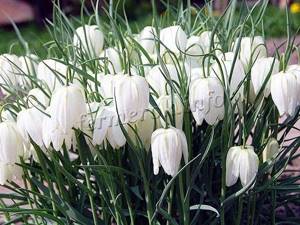
Photo of Alba's checkered hazel grouse
Interesting!
You should not purchase already flowering, dug up hazel grouse from the market for planting. They will have to be grown for several years before the next flowering!
Landing
Gardeners prefer hazel grouse to other garden plants because of its unpretentiousness and beauty. The bulbs, consisting of several scales, contain buds with the help of which they reproduce.
There are general rules for planting this plant:
- September-October are considered favorable months for planting hazel grouse; late planting will lead to freezing of the bulbs or lack of flowering.
- The place where the new plant is determined must be sunny, partial shade is allowed.
- The bulbs are handled with care; damage will lead to the death of the flower.
- Before planting in the ground, they are treated with a manganese solution.
- Soil that is too wet and cold is not suitable for planting; the bulbs will rot.
- The planting depth is about 12 cm for low flowers, about 20 cm for tall ones.
- The bulbs are placed sideways in the soil, sprinkled with coarse sand.
In general, the soil where a garden plant is planted should be nutritious and light. It is recommended to add peat to the prepared holes.

Planting in autumn, when to plant
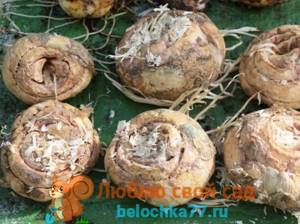
Purchased or previously dug up royal hazel grouse bulbs are planted in the ground in the fall. Depending on weather conditions in the climate zone where a particular site is located, planting dates may shift.
For example, in the southern regions with a warm, favorable climate and mild winters, bulbs can be planted in September-October, and in the Urals and Siberia with a harsh climate, it is recommended to plant a little earlier - from late August to early September. The bulbs planted during this period will have time to adapt and take root in the soil, so they will not freeze out.
The technology for planting royal hazel grouse is similar to the technology for planting bulbous flowers and includes several operations.
Choosing a planting site and preparing the soil
In order for the royal hazel grouse to delight you with its spring flowering, it is necessary to properly organize its planting site. These flowers prefer sunny, well-lit places, but can also grow in light openwork shade. The planting site must be well protected from the winds, otherwise during the growing season there is a risk that the tall stem of the flower will break.
A couple of weeks before planting the bulbs, it is necessary to prepare the planting site. To do this, dig a hole into which a layer of sand and drainage (crushed stone, broken brick, etc.) is poured. This will help protect the delicate hazel grouse bulbs from rotting during heavy autumn rains, as well as during intense snow thawing in the spring. The sand will not allow the top layer to sink down, and the drainage will ensure a high-quality outflow of excess water, and it will not stagnate. The rest of the hole needs to be filled with a nutritious mixture of turf soil with peat and humus. The depth of the pit for planting royal hazel grouse is usually 40 cm.
Planting hazel grouse bulbs
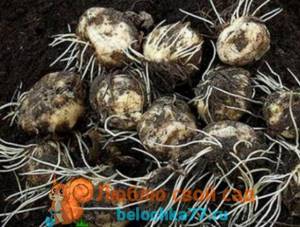
Since hazel grouse is a bulbous flower, it is planted in exactly the same way as other representatives of this group, that is, to a depth of 2...3 times the diameter of the bulb itself. Since the royal hazel grouse bulb is quite large in size, the depth of the planting hole is 25...30 cm. The distance between adjacent bulbs should be at least 25 cm. In this case, each of them is lowered with its bottom into the ground, the roots are straightened.
Some gardeners plant hazel grouse seedlings sideways or at an angle of 450, sprinkling them with sand. This planting method makes it possible to organize good protection of the delicate bare bulbs of hazel grouse without scales from the appearance of rot.
After all the specimens are sitting in their places, they are covered with earth, and a layer of humus mixed with ash, the thickness of which is 15 cm, is placed on top. During planting, the bulbs of this plant must be handled very carefully and try to avoid them under any circumstances. damage. It is better to treat them immediately before placing them in the ground with a weak solution of potassium permanganate or sprinkle them with crushed coal.
Also, in parallel with planting the bulbs, it is recommended to immediately stick pegs into the ground, to which the plant stems will subsequently be tied. It is best to use bamboo or wooden sticks, such that they rise half a meter above ground level when installed.
If you install pegs in the spring, there is a high risk of damaging the bulb itself in the ground, so you should take care of future gartering of the stems in the fall.
How to plant imperial hazel grouse bulbs: video
Grouse care
Planting and care for different types of hazel grouse are minimal. With proper care, the flower will delight you with bright buds and strong stems, which will be a real decoration of the garden.
It is important to water the hazel grouse if the summer is too dry; the soil should not dry out.
After watering, it is recommended to weed the beds and sprinkle them with peat or wood ash. It is also necessary to feed the plant with special dry fertilizers. The first part is added at the end of April, the second - in August.
Reproduction
The flower reproduces by seeds or bulbs. Both methods are good and produce flowering quickly.
- The seeds are collected as soon as the leaves of the plant turn yellow. Sowing is done in enriched soil. Two years after planting, the strengthened bulbs are dug up and stored in a warm, dry place.
- The bulbs of most varieties of hazel grouse increase in size over time, and “babies” grow. After a couple of years, they are dug up and separated and then planted in the ground.
After flowering
After the flowers fade and the boxes begin to dry out, the hazel grouse will still delight you with its greenery for some time. Then, around the beginning of July, they begin to dig up the bulbs and place them in storage. They are washed with warm water, dried and put into a room where the temperature is not higher than 30 ° C, providing a constant flow of fresh air. New roots grow around the end of summer, and the bulbs become suitable for planting.
Hazel grouse breeding
Reproduction of fritillaria occurs vegetatively ; annually planted bulbs are replaced with new ones, and a daughter bulb is formed. The number of children depends on the variety of perennial.
Bulbs of the “checkerboard” variety are not dug up and divided every year; it is enough to do this once every 6-7 years. During this growing period, they do not stop blooming, but there are no more flower stalks. Large-bulb varieties such as imperial, Persian, and pale-flowered are dug up annually. Hazel grouse with small bulbs (foxberry, Mikhailovsky) can not be dug up for 3-4 years, while covering it with black material to warm the bulbs.

The easiest way to propagate hazel grouse is by planting bulbs.
If desired, reproduction of hazel grouse, including “checkerboard” ones, is also carried out from seeds . For the seed pods to ripen, favorable weather is required; if there is a lot of rain in the spring, the seeds may rot. In a warm place, in open ground or in a greenhouse, a separate bed is prepared with fertile soil mixed with leaf humus. The seeds are planted in grooves, to a depth of 1 cm, the distance between them is 10 cm. The seeds should be sprinkled with a layer of peat up to 2 cm on top. Growing the bulbs lasts until next year, then, after the leaves dry, they are dug up and stored in a ventilated room until autumn. The bulbs of these perennial plants need to be heated at a temperature of about 30 degrees for several weeks in a greenhouse.

Hazel grouse seeds
Flowering of fritillaria grown from seed occurs in 4-5 years, and in large hazel grouse - only in 7-8 years. Watering is moderate, the soil should be moist, but not soggy, then it is generally better to reduce watering to 2 times a month. Seedlings need to be fed between the twentieth of April and the beginning of June, after flowering, with dry complex fertilizers.
Advice! You should not buy perennials that are already flowering for planting; they are often sold. Such a hazel grouse, even if it does not die, is very difficult to grow until the next flowering. It is for the “chessboard” variety that bulbs are purchased that are not overdried—dry ones are no longer viable.
Reproduction of hazel grouse by bulbs provides good repeatability of varietal characteristics; this is not always possible to achieve using the seed method.
Mr. Summer Resident warns: mistakes that will prevent hazel grouse from flowering
Some gardeners do not wait for the hazel grouse to bloom, and this is due to several common reasons:
- cool and humid summers contribute to the rotting of the bulbs (they are heated and dried naturally);
- small bulbs (if the size is less than 5 cm there will be no flowering, the plant is gaining strength);
- growing in one place (they begin to divide and do not bloom; to avoid this, dig up and store before autumn planting);
- incorrect planting depth;
- unsuitable soil (arid, unenriched soil is not the best place for flowers);
- winter with a small amount of snow (lack of snow cover leads to freezing).
In order for the plant to bloom and please the eye every year, you need to follow the rules of planting and care. They do not require much effort, but the garden will acquire extraordinary beauty.

